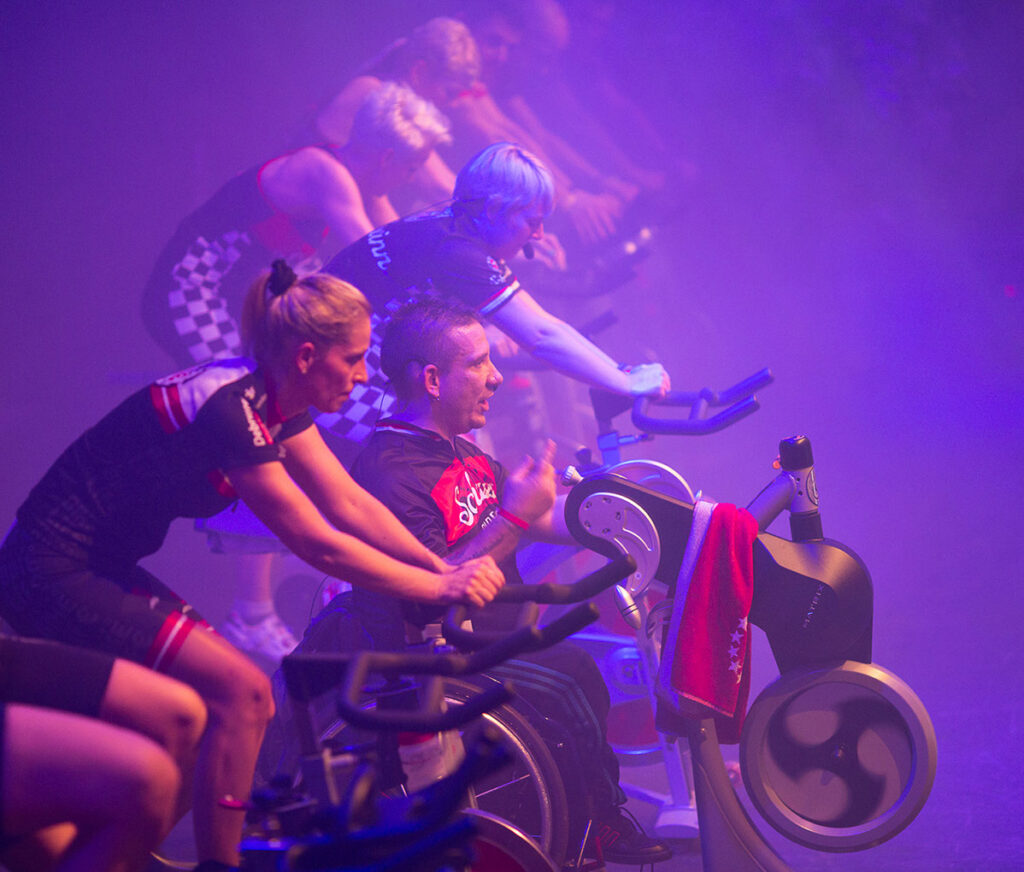Indoor cycling academy, Rockstar instructors
Dis/ability

What led you to become an indoor cycling coach?
Initially, it was just to prove people wrong – to show it could be done. I’d always been active: I was a wheelchair racer from the age of eight to 15 years and even beat Paralympic gold medallist David Weir once, although it was a bit of a fluke!
“I was previously a wheelchair racer and even beat Paralympic gold medallist David Weir once!”
I was working as a personal trainer at Aspire Leisure Centre in the UK when, in 2009, they introduced indoor cycling and asked who’d be interested in teaching it. They weren’t sure if someone in a wheelchair would be able to do it. I was up for the challenge.

That April, I did Schwinn’s Bronze level qualification. It was a two-day course and wasn’t modified at all for wheelchair users, so when it came to teaching a class, a colleague had to get on the bike to demo what I was asking people to do. It worked, though, and I was the first wheelchair user in the world to complete the course.
What’s your role now?
I’m now a Gold level Schwinn coach and have done a few mass participation events, up on-stage alongside able-bodied coaches. I also still work at Aspire as a personal trainer – I’ve been a PT since 1996 – and an indoor cycling coach, teaching classes using a krankcycle.

Aspire is a very inclusive gym. On average across the UK, 1–2 per cent of a gym’s members will be disabled. At Aspire it’s 28 per cent, and that’s reflected in our team too.
My wife comes to my classes – she’s also in a wheelchair and uses a krankcycle – and although most of my participants are able-bodied, many have some sort of health consideration such as overweight, heart conditions, prediabetes and so on. It’s a very inclusive class that attracts a broad array of people. I think they see me and think: ‘If Graham can, I can!’
What’s your coaching style?
I’ve done disability training modules through the YMCA, but above all I believe empathy is key. It’s not about pushing everyone to do 160 RPM. It’s about doing what you can. That’s an ethos I try to bring to every class.
Obviously I can’t get on a bike to demo the moves, so my focus is on verbal cues. Most of my participants have been coming to class for years, so they know exactly what I mean!
“I want to get as many people fit as possible, regardless of their ability. Indoor cycling is a huge part of that”
I also do a lot of going round the room, interacting with people individually. There are only 15 bikes and four krankcycles in the Aspire studio, so there’s plenty of scope to offer a personal touch and tailor the class to the needs of those in the room.
Programming-wise, it’s all about fitness cycling – an authentic approach to indoor cycling where you don’t do any moves you wouldn’t do on an outdoor bike.

How accessible is the fitness sector?
It’s better than it used to be, but there’s still a long way to go. I’ve tried to instruct at other clubs but they simply haven’t been accessible.
Krankcycles are also hard to come by in the UK nowadays, which is a great shame as it isn’t only wheelchair users they’re good for. They’re also good for people who’ve had knee or hip replacements. I believe every club should have one or two in their cycling studio.
And generally, I’d like to see more of the big companies – manufacturers, training providers, operators – showing that it can be done. That accessibility can be mainstream.
What’s your mission?
I want to get as many people fit as possible, regardless of their ability. Indoor cycling is a huge part of that: it’s low impact, you can adjust the workout to your level and it brings a wealth of fitness benefits. It’s a great workout for everyone.

What are your goals?
I’d like to open my own gym or PT studio, including indoor cycling.
I’d like to work with big companies to drive accessibility up the agenda.
And I’d like to become a Schwinn master trainer, so I can get more people with impairments qualified as coaches. It’s a great career. My advice: don’t think about it – just get out there and do it!

Conceived, powered and funded by BODY BIKE®, RIDE HIGH has a simple mission: to celebrate and champion the very best of indoor cycling, sharing ideas, stories and experiences from around the world to inspire the sector on to even bigger and better things. Subscribe for free by leaving your details below and we'll send indoor cycling's hottest news direct to your inbox three times a year.






